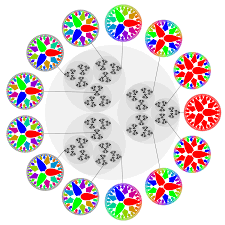Activity I

Host: Michael Gaiewski (UConn)
An Introduction to Finite Element Methods (FEMs)
Abstract: In this activity, we will be estimating a solution to a differential equation using what are known as Finite Element Methods (FEMs). We will use techniques learned in calculus and linear algebra to construct a finite element basis, set up a linear system with unknown coefficients, and compare our estimate to the true solution. It is recommended you have access to a computer, as we will be doing some graphing, calculating integrals, and solving a linear system, all of which will be made easier by using a computer.
The Undecidable and the Undefinable
Abstract: In mathematical logic, we can use the language of first-order arithmetic to formalize statements such as "n is an even number", "for every natural number n, there is a natural number n+1". In computability theory, we have the notion of computable sets. We can combine these ideas to discuss computable sets of first-order arithmetic formulas (i.e., there is an algorithm that can tell you whether a string of symbols is a first-order arithmetic formula or not). This leads to some natural questions: given a first-order arithmetical statement, is there an algorithm that can determine its truth or falsity? Can first-order arithmetic encode what it means for a statement to be true? In this talk, we will go over the basic ideas that are needed to answer these two questions, and we will discuss two key results which both give a negative answer. No background knowledge in logic will be assumed.
Activity II

Host: Java Villano (UConn)
Activity III

Host: Hyungue Lim (UConn)
Data Analytics & Data Science
Abstract: During this activity, I will walk through the general process of data analytics and data science.
An Exploration of Size and Distance
Abstract: In this session, we will explore the p-adic numbers, which are an infinite collection of fields analogous to the real numbers. We will explore the p-adic absolute value and p-adic metric, and will discuss a proof that the p-adic numbers and real numbers are the only way to complete the rationals.
Activity IV

Host: Benjamin York (UConn)
Poster Abstracts:
| Characterizing the 4231-Avoiding, Shallow Permutations by Mariano Estrada II (University of Idaho) | Petersen and Tenner’s depth measures the distance of a permutation from its symmetric group’s identity and is known to be bound below by the average of two other measures of distance, length and reflection length. Permutations where this bound is an equality (i.e., permutations that are shallow) are known to not be characterizable by the containment and avoidance of patterns. However, using Hadjicostas and Monico’s recursive definition for shallowness, we show that the subset of shallow permutations which avoid 4231 can be characterized in this way. Such permutations are the ones which avoid 4231, 3412, 34521, 54123, 365214, 541632, 7652143, and 5476321. | |
| Paths of the Fractional Gaussian Field on S1 and the Torus by Andrew Gannon (UConn) | In this poster, we begin by defining the Fractional Gaussian Field (FGF) X_s on S1 with parameter s. For s>1/4, we index our Gaussian random variables by points on the circle S1, and for s\leq 1/4 we index these random variables by smooth, real-valued functions on S1. Using methods from Fourier analysis and probability, we prove that these definitions make sense (i.e. that the series defining the FGF pointwise converges almost surely). We then prove that the sample paths of X_s are almost surely Lipschitz when s>3/4, Holder with exponent 1/k for s>1/2k, and k times continuously differentiable for s>(k+1)/2. We then prove the analogous results on the d dimensional torus Td. The theory of FGF's on manifolds is currently a topic of interest to cosmologists studying cosmic microwave background radiation and particle physicists studying Liouville quantum gravity. We outline a procedure for defining the FGF on an arbitrary compact Riemannian manifold (M,g), using tools from functional analysis and probability. Our current interest is in regularity conditions for paths of FGF on the sphere S2, which are more difficult to study due to the sphere's positive Ricci curvature. | |
| Dehn Invariant Zero Tetrahedra by Abdellatif Anas Chentouf (MIT) | We describe previous work towards the classification of Dehn invariant zero tetrahedra, providing partial results based on specific conditions on dihedral angles and symmetries. We also present new tetrahedra of Dehn invariant zero which, up to our knowledge, were previously unknown. The work is also related to the notion of tiling tetrahedra. This work was joint with Yihang (Kimi) Sun, supervised by Prof. Bjorn Poonen. It was conducted as part of the undergraduate research program at MIT. | |
| Computing Extreme Values of Continuous & Discrete Fractional Gaussian Fields on Manifolds by Connor Mars (Bowdoin & UConn REU 2022) and Tyler Campos (Yale & UConn REU 2022) | Fractional Gaussian Fields (FGF's) are a family of stochastic processes that can be defined on any compact manifold M and model the behavior of random oscillations on M. FGF's can be used to model for the behavior of bosons in particle physics, but they also find use in exploiting the connection between random matrix theory and number theory to prove the Riemann Hypothesis. For these reasons, studying the extreme values of these fields is of great interest to a variety of subjects, and yet computing the distributions of the maxima and minima of the FGF are challenging, open problems. We define discrete fractional gaussian fields on manifolds M that converge to the continuous fractional field, and by numerically simulating the discrete fractional gaussian fields, we generate conjectures for the behavior of the extreme values of the continuous field. |